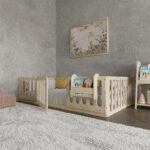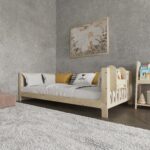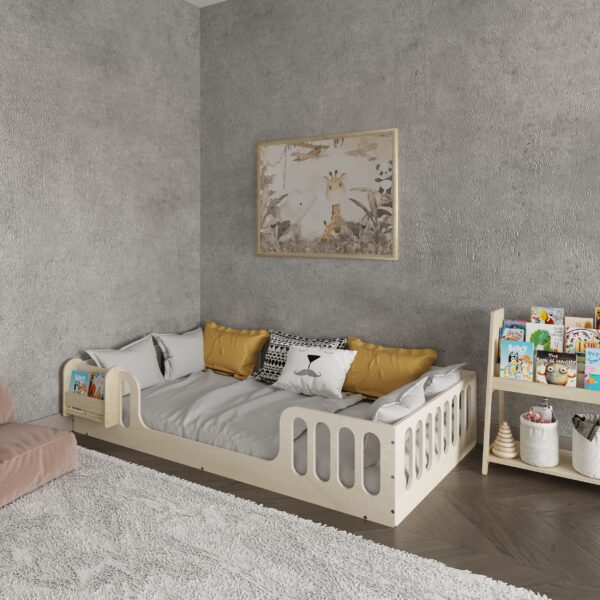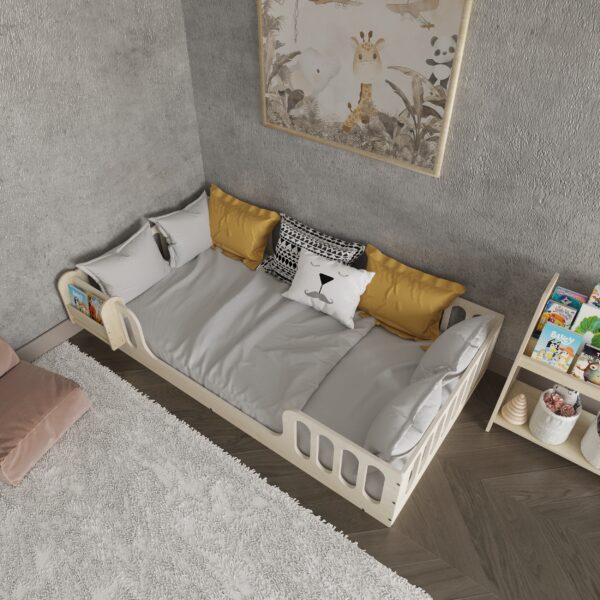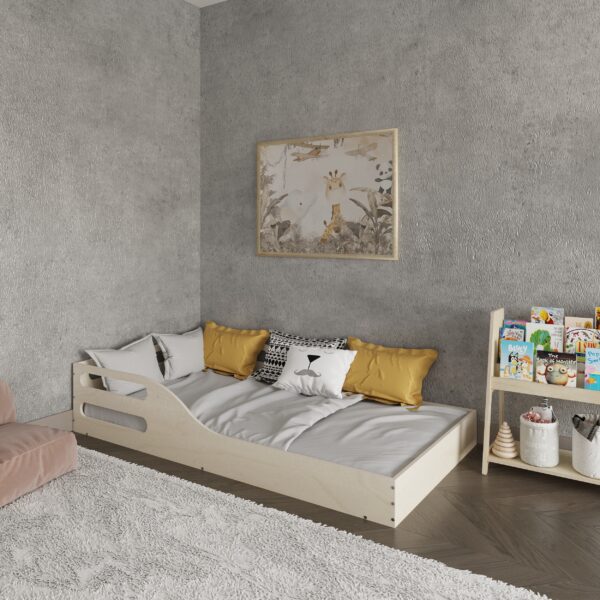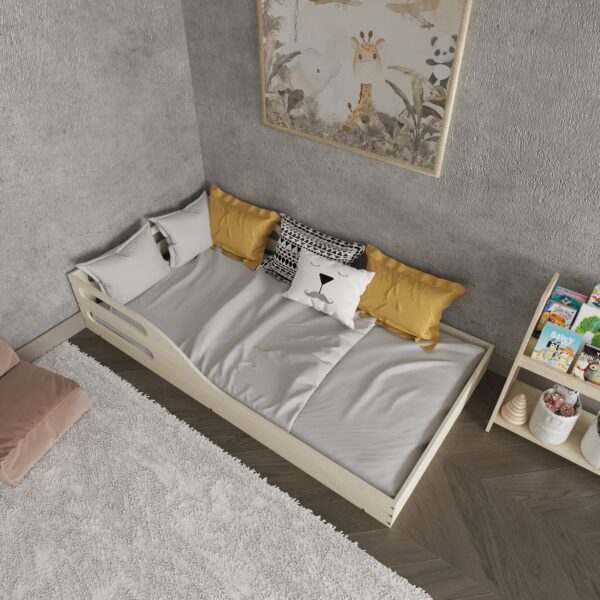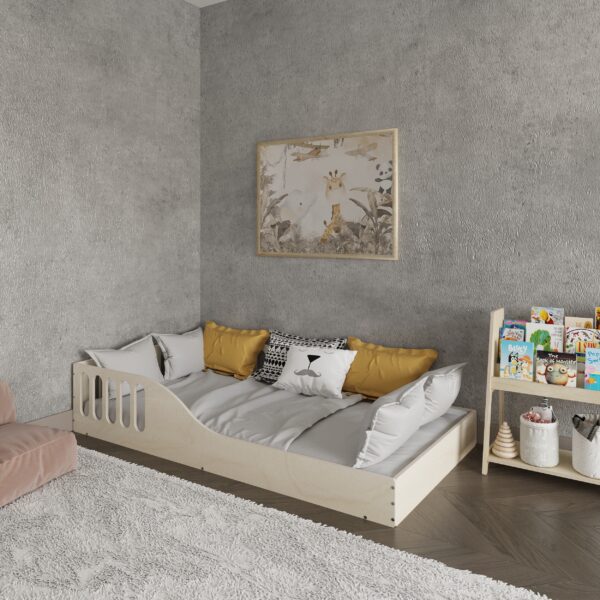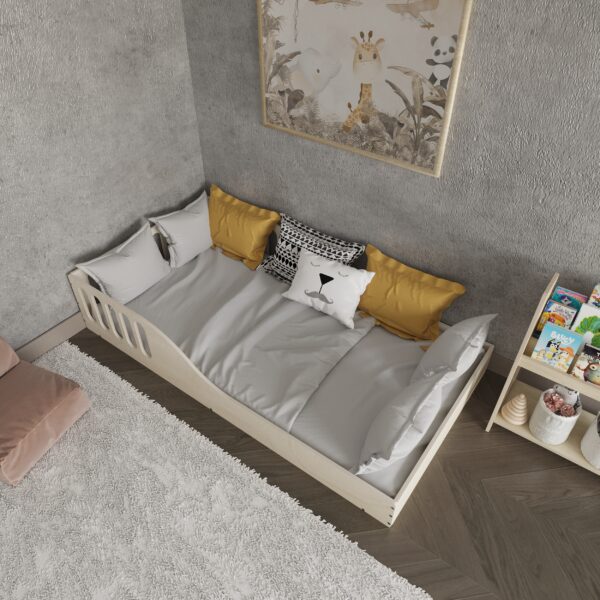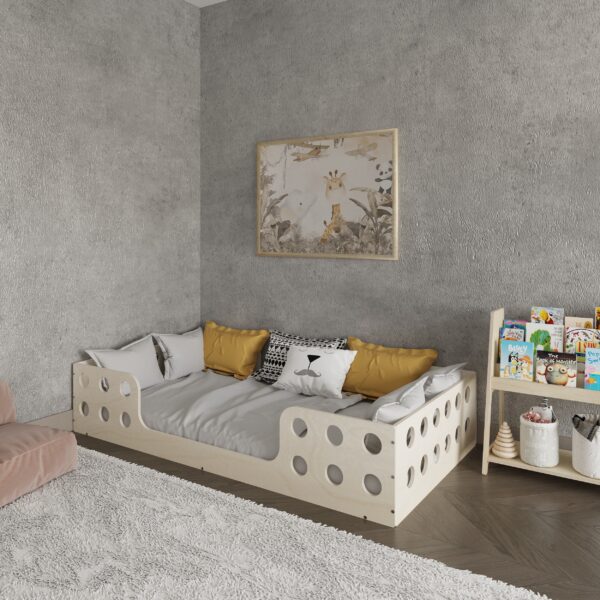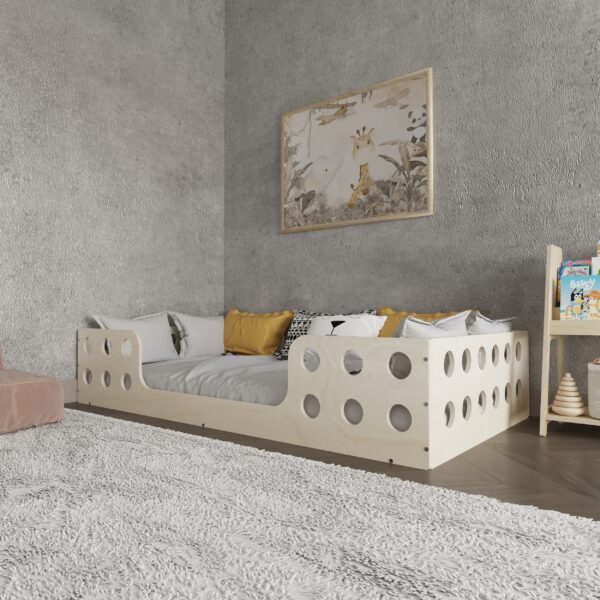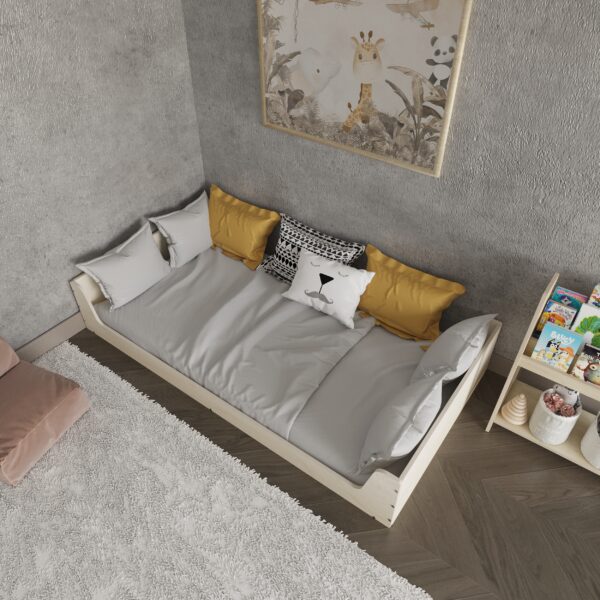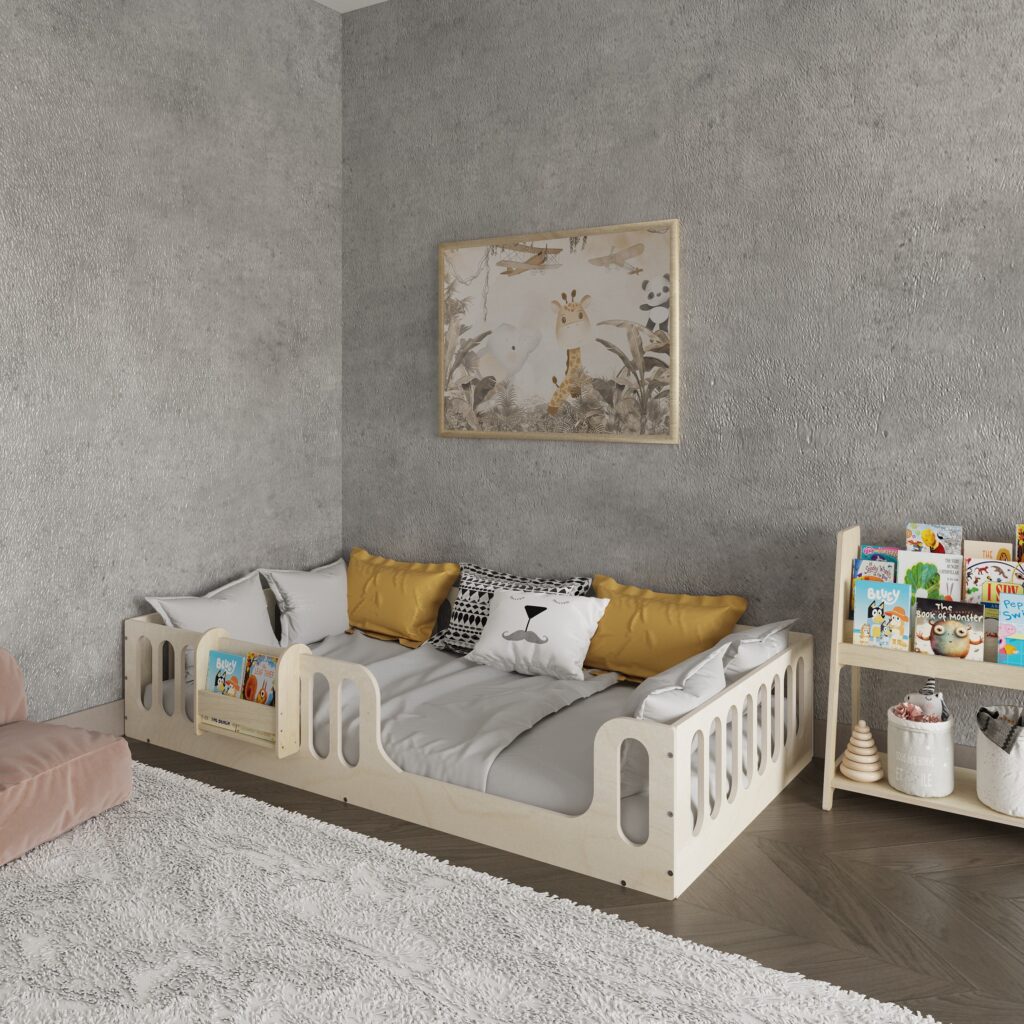No products in the cart.
Montessori Floor Bed
Viewing 13 - 17 of 17 Products
Select options
This product has multiple variants. The options may be chosen on the product page
-20%gifts
Montessori Floor Bed Kindernook
$298.75 $239.00
Select options
This product has multiple variants. The options may be chosen on the product page
-20%gifts
Montessori Floor Bed Slumberjoy
$298.75 $239.00
Select options
This product has multiple variants. The options may be chosen on the product page
-20%gifts
Montessori Floor Bed Sleephood
$298.75 $239.00
Select options
This product has multiple variants. The options may be chosen on the product page
-20%gifts
Toddler Floor Bed Dreamgarden
$298.75 $239.00
Select options
This product has multiple variants. The options may be chosen on the product page
-20%gifts
Toddler Floor Bed Peacebed
$298.75 $239.00
Table of Contents
The Montessori Floor Bed: A Comprehensive Guide
Montessori Philosophy and Floor Beds: A Perfect Match
Understanding the Montessori Philosophy
The Montessori philosophy that Dr. Maria Montessori created emphasizes the development of independence and child-initiated learning while supporting natural child development. The approach establishes educational spaces that grant freedom to discover while students learn autonomously through natural curiosity.
The Benefits of a Floor Bed
Montessori bedroom design includes the essential floor bed component that provides various developmental advantages for children. Through this sleeping system children develop freedom of movement while gaining self-regulation of sleep times and learning independent skills. The sleeping environment from floor beds suits children at all developmental phases because it adjusts to their changing requirements.
The Process to Build an Optimal Montessori Bedroom with Floor Beds
Designing a Safe and Stimulating Bedroom
Safety represents the main concern when establishing a Montessori bedroom. Children need protection from their bedroom environment through outlet covering and furniture anchoring and removal of dangerous materials. The area should stimulate sensory experiences and support exploration by placing accessible materials such as toys and books of different age levels.
Choosing the Right Floor Bed
The correct floor bed selection plays an essential role in protecting your child’s safety and comfort. Select a floor bed that provides low height safety while being made from durable non-toxic materials which extend product longevity. The mattress requires firm support together with breathable materials for temperature control. Select a bed size which enables your child to move about freely yet take into account their expected future growth requirements.
Placing floor beds with bedroom organization structures forms an essential part of the bedroom arrangement process in Montessori settings.
The final design of Montessori spaces depends on the combined layout of floor beds with bedroom organization elements. Place the bed away from walls to ensure easy access from all directions. The placement of low shelves with toys books and materials should encourage independent exploration by children. The bedroom needs to have designated resting areas and recreational zones together with a dressing area to create organized spaces with meaningful functions.
A floor bed serves an essential purpose to help children get quality sleep.
The Science Behind Quality Sleep
The physical growth and emotional stability and cognitive development of children depend heavily on quality sleep. Children require sleep to achieve development while building their immune system and forming lasting memories and regulating their emotional state. The floor bed design offers children their best sleeping conditions to develop proper sleep patterns.
Tips for Establishing a Healthy Sleep Routine
The creation of reliable sleep schedules stands as the core requirement for delivering high-quality sleep experiences while using floor beds. Before going to bed create relaxing activities which include reading or light stretching. People should establish regular sleep patterns daily including weekends to maintain proper bodily operations. The bedroom should have no light and no noise and the right temperature to create the conditions for peaceful rest.
Overcoming Sleep Challenges
Some children experience sleep-related difficulties after their family starts using floor beds. Most children face problems with falling asleep while displaying nighttime disruptions and rising too early. You can solve these problems by creating a peaceful sleeping environment and by providing reassurance while teaching your child to sleep independently through various stages. Your child requires regularity and patience to establish proper sleep patterns.
Promoting Independence and Confidence with Floor Beds
Encouraging Self-Directed Choices and Exploration
Through its design the floor bed allows children to make their own choices while they move around their environment. Children with safe sleeping areas can decide freely between sleeping or resting or playing on their own. Self-regulation abilities develop through autonomy because children learn to manage their own needs and desires.
Building Self-Help Skills and Responsibilities
The design of floor beds establishes an essential platform for children to learn skills which will lead to independent living and responsibility management. Children acquire their ability to care for their clothing while learning to keep their sleeping area clean and manage their personal items. Learning practical life skills helps students become independent while building their self-reliance and creating feelings of accomplishment. Start by teaching your child basic life skills such as blanket folding and toy organization.
Nurturing a Sense of Ownership and Confidence
A floor bed in Montessori bedroom helps children develop ownership and confidence. When children possess their own personal space they acquire the ability to showcase their personality through their preferred items and develop a sense of importance. Let your child handle bedroom decoration responsibilities while they choose bedding selections and arrange their belongings. Children discover their individual identity while making decisions which strengthens their confidence during this process.
Transitioning from a Floor Bed to a Regular Bed
Children usually transition from floor beds to standard beds when they reach certain developmental milestones. Every child must progress at their own developmental pace for switching to a regular bed. Different children have different preferences about bed height so children may choose a higher position or need extra support. When the time comes, ask your child to choose their new bed together with bedding as you both experience this achievement.
The Integration of Floor Beds in Montessori Daily Schedules
Morning and Evening Routines: A Montessori Approach
Your child will learn independence alongside self-care abilities by following Montessori principles when you introduce a floor bed into their daily schedule. Your child needs to learn self-wake up skills followed by dressing and making their bed before starting their daily tasks. The evening environment should be calming because it helps children relax and think about their day. By participating in their evening routine with your child you will help them build independence along with personal responsibility.
Practical Life Activities: Independence and Skill Development
The floor bed in Montessori bedrooms provides children with many practical life exercises which support their independence while teaching them new skills. Guide your child to develop independent skills by teaching them how to prepare their bed and perform duties like folding clothes and organizing their belongings. The activities enhance both fine motor skills and concentration and promote organized thinking. Praise your child’s accomplishments because it demonstrates their contribution to the team.
The establishment of relaxing bedtime procedures helps children fall asleep peacefully.
Young children need daily naps which enable them to rest while simultaneously supporting their growth and restoration process. Create a floor bed area in your child’s bedroom where you will establish a relaxing naptime schedule. The lights should be lowered while playing soft music or white noise and creating a comfortable resting environment. Your child needs to learn self-settling abilities but you should offer comforting assistance when they need it. You should respect your child’s sleep patterns while helping them learn to wake up independently.
Bedtime Rituals for a Peaceful Transition to Sleep
A floor bed needs a strict peaceful bedtime schedule to enable children to move from awake to sleep state smoothly. The bedtime routine should include bathing as its first step followed by reading before ending with physical contact. Encourage your child to engage actively throughout this process because it helps them feel secure and in control. The daily routine must include selection opportunities between pajamas and bedtime stories to help your child develop independence while learning decision-making skills.
Designing Floor Beds to Provide a Sensory Experience
Exploring Textures, Colors, and Patterns
The floor bed setting in Montessori bedrooms enables parents to create an environment that stimulates their child’s developing sensory experiences. The bedding along with pillows and room decorations should incorporate multiple textures in addition to various colors and patterns. Choose materials that are soft, cozy, and inviting to touch, such as organic cotton, wool, or bamboo. Show your child various pillows and blankets with different textures and weights to help them understand their preferences.
Natural Elements Should Be Integrated into the Bedroom Space
The Montessori bedroom benefits from natural elements which create peacefulness and awe while establishing environmental connections. The room design should include wood furniture and woven baskets and organic fabrics as natural elements. Placing plants and shells and stones on low shelves lets your child observe and touch these treasures. Natural illumination enhances the bedroom by using open curtains throughout daytime hours for your child to view the outdoors and receive sunlight.
The Mobiles together with Stimulating Objects Help to Enhance Sensory Development.
Mobiles together with stimulating objects function as vital tools for early childhood sensory development. A visually pleasing mobile should be placed above the floor bed to give your child an observation point and exploration opportunity. Your child will focus on mobiles featuring high-contrast colors and interesting shapes and gentle movements. The bed area should have stimulating objects such as soft rattles and textured balls placed in reach for children to discover.
A welcoming and comfortable atmosphere in the Montessori bedroom emerges from the combination of rugs and curtains and cushions as soft furnishings.
A soft plush rug should define the floor bed area because it creates a warm and inviting space for your child to discover. The installation of light-filtering soft and lightweight curtains will help create a private atmosphere. The bed should have only a small number of specifically chosen cushions and stuffed animals to serve both rest time purposes and friendship needs.
The floor bed serves as the best play area that supports imaginative development and playful activities for children.
Open-Ended Toys and Materials for Creative Play
The floor bed creates a perfect foundation for children to engage in playtime discovery. You should choose open-ended toys and materials which stimulate creativity and encourage imagination and problem-solving abilities. Your child should have wooden blocks together with nesting cups and stacking rings and basic puzzles which operate in multiple ways. You should place these educational materials at low levels which your child can easily reach to play without supervision.
The floor bed area should contain welcoming spaces with Montessori-inspired shelf activities that stimulate focused learning and discovery.
Montessori shelf activities create engaging play stations that direct children toward specific learning and discovery activities. The low shelves should contain three thematic activity zones that include language materials and books, sensory exploration through tactile and visual discrimination tasks, and practical life components with self-care and fine motor skill development tools. Periodic changes in activities will help prevent boredom and generate new learning opportunities which match your child’s changing needs and interests.
The floor bed offers an excellent setting for pretend play alongside storytelling activities which promote language development and foster imagination and social abilities.
The floor bed serves as an ideal space for imaginative play and storytelling which helps develop language skills and creativity along with social abilities. The selection of suitable play items including dolls and animals and play food will help children develop their creative abilities through imaginative play. The placement of books at a low height near the bed allows your child to read independently and discover new stories. You should participate in pretend play activities with your child to demonstrate storytelling methods while encouraging their independent narrative development.
The bedroom includes spaces for art and music activities.
Art together with music functions as essential elements for creative expression along with sensory development in children. Montessori bedroom spaces should integrate art materials along with musical instruments to enable children to investigate independently. A designated art space containing paper with crayons and secure painting tools lets your child create without limitations. Your child can learn about sound and rhythm through the exploration of simple musical instruments including a small drum and a xylophone or a set of bells.
Through the Montessori floor bed children can establish basic educational principles to build independence and learning confidence.
The floor bed within the Montessori-Inspired bedroom teaches essential learning habits which become lifelong practices for children.
A Montessori-inspired bedroom setup featuring a floor bed establishes essential learning habits that help children develop independence while gaining confidence and learning enthusiasm. Your child will benefit from physical growth and cognitive abilities and emotional development through a learning environment which respects their natural learning patterns. The essential learning abilities gained in this educational environment including self-regulation and problem-solving and creativity will help your child excel in their future academic work and future educational settings.
The Montessori floor bed establishes an environment that helps children gain independence during their learning processes.
Children develop autonomy while learning responsibility through self-motivation practices which enables them to succeed in both Montessori classrooms and traditional educational settings. Your child will preserve their discovery passion together with confidence and resilience because their Montessori bedroom establishes a solid foundation when they transition to new educational environments.
What age is appropriate for introducing a floor bed?
Floor beds can be introduced as early as infancy, typically around 2-6 months old, or whenever the child is able to roll over and sit up independently. However, it’s essential to ensure the bedroom is thoroughly childproofed and the child is developmentally ready.
Are floor beds safe for babies and toddlers?
Yes, when properly designed and used in a childproofed room, floor beds are safe for babies and toddlers. Ensure the bed is low to the ground, the mattress is firm, and there are no hazards within the child’s reach.
How do I transition my child from a crib to a floor bed?
Start by childproofing the room and setting up the floor bed. Gradually introduce the bed during playtime, encouraging your child to explore and become comfortable with the new space. Begin with short naps and work up to overnight sleep.
What type of mattress is best for a floor bed?
Choose a firm, supportive mattress that allows for proper spinal alignment. Avoid soft or plush mattresses that may pose a suffocation risk. Organic and non-toxic materials are recommended for a healthy sleep environment.
How do I keep my child from rolling off the floor bed?
Place the floor bed away from walls and furniture, allowing ample space for movement. You can use a small, firm bolster or rolled-up towel under the fitted sheet to create a subtle barrier, but avoid using pillows or blankets that may pose a suffocation risk.
What if my child keeps getting out of bed and playing instead of sleeping?
This is a normal part of the learning process. Gently and consistently guide your child back to bed, reminding them that it’s time for sleep. Establish a calming bedtime routine and create a sleep-conducive environment to encourage rest.
Can I use a floor bed if I have multiple children in the same room?
Yes, each child can have their own floor bed in a shared room. Ensure there is enough space between the beds for safe movement and consider using low dividers or shelves to create a sense of individual space for each child.
How do I keep my child warm on a floor bed without blankets?
Dress your child in warm, breathable layers, such as a footed sleeper or sleep sack. Keep the room at a comfortable temperature and consider using a small, child-safe space heater if needed. Introduce a light blanket once your child is older and less at risk for suffocation.
Can I use a floor bed if my child has special needs or mobility issues?
Floor beds can be beneficial for children with special needs or mobility issues, as they allow for easier access and independence. However, consult with your child’s pediatrician or occupational therapist to ensure the setup is appropriate and safe for your child’s specific needs.
How long can my toddler use a floor bed?
Toddlers can use floor beds for as long as they feel comfortable and secure. Many children transition to a regular bed between 3-5 years old, but some may prefer the floor bed setup for longer. Follow your child’s lead and make the transition when they are developmentally ready.
